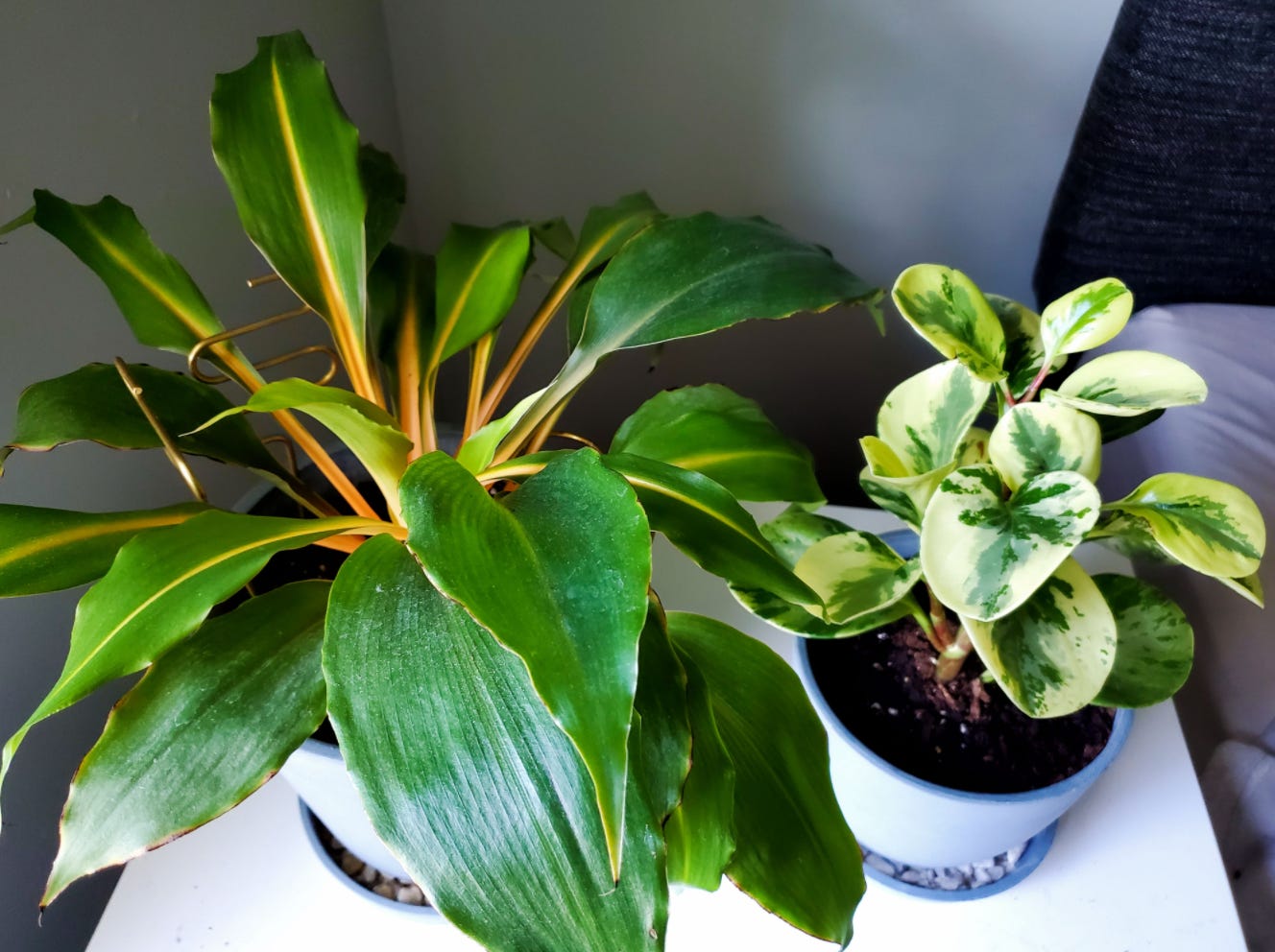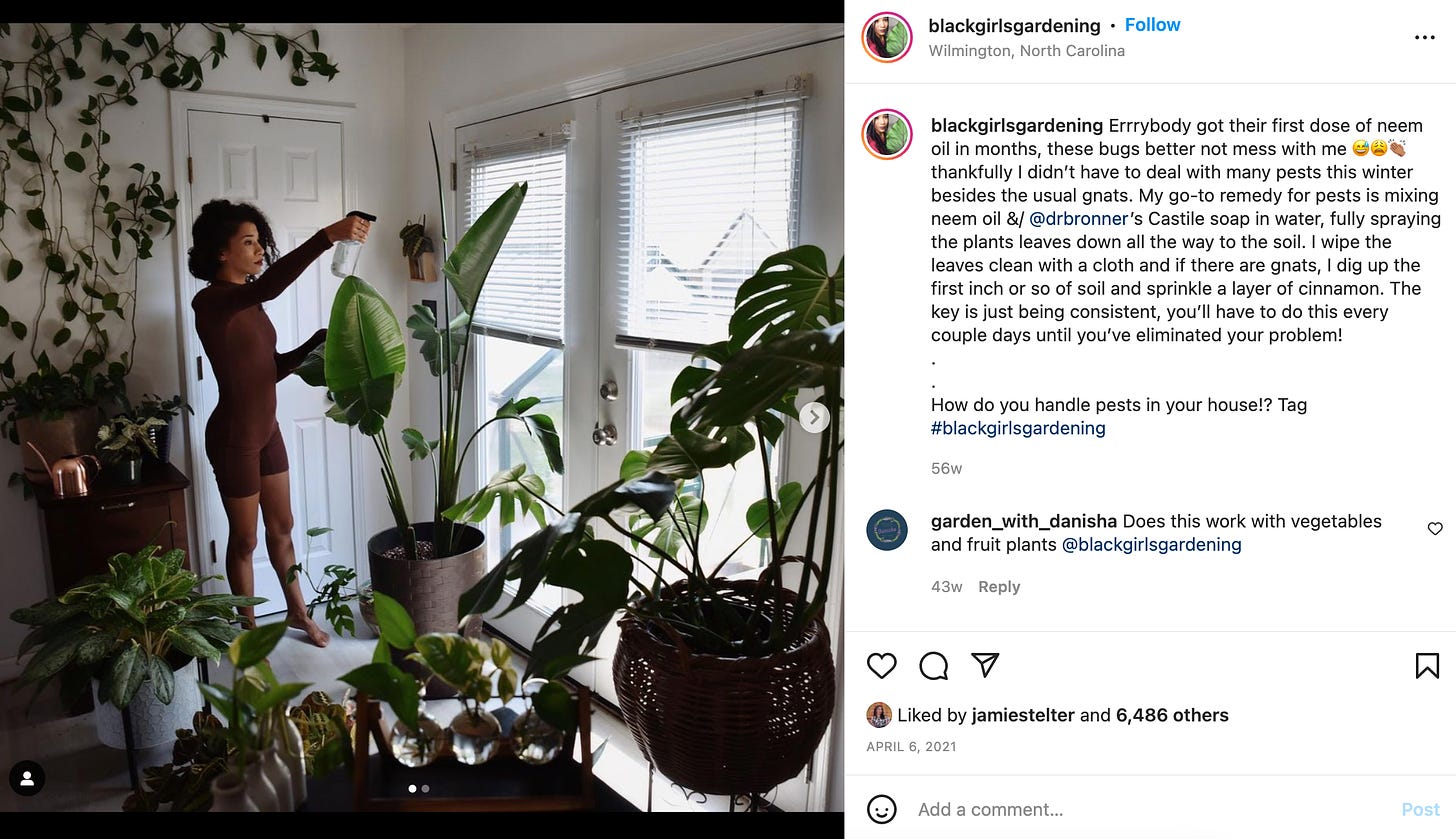Houseplants as a Means of Black Joy and Queer Resistance
Culture Study Takeover with Stephanie Sendaula
Welcome to Culture Study Takeover Week 2! I love running this newsletter, but I also periodically need to take a small break from running this newsletter. Subscription dollars make it possible for me to pay an excellent rate for someone to curate the newsletter — and give a platform to people with different identities and perspectives than my own. This week, I’m so thrilled to have beloved Culture Study community member Stephanie Sendaula at the helm.
And if you value this work, and this platform, and these perspectives, and find yourself opening this newsletter every week — please consider becoming a paid subscribing member. Your contributions make this work sustainable.
Hello Culture Study! My name is Stephanie Sendaula and I’m absolutely delighted to be guest hosting Culture Study this week. I’m a librarian based in NJ, and I enjoy cooking, baking, gardening, and spending a lot of time with my plants.
I’ll be honest–I have a complicated relationship with plants. When I initially saw the Tuesday Thread in this newsletter from early March about the plants in your childhood home I thought, bold of anyone to assume everyone has plants in their childhood home. My family could barely take care of each other, let alone anything in addition to people within the family unit. In my family, raising children took a village, and each person in the village brought layers of intergenerational trauma to the task (along with the unheralded ability to take secrets to the grave).
Plants were items that I saw in the homes of white friends; they always felt unapproachable and inaccessible, in a way that signified a status that was just out of reach. I knew better than to ask my parents, grandparents, or aunt (all members of the aforementioned village) why we didn’t have any. They had better things to worry about, like where our next meal was coming from or whether they could afford any of the regular bills that kept arriving in the mail.
Growing up in that environment, sometimes safe, but mostly unstable, it took a long time for me to accept that I could, in fact, have a plant collection. When I was a child, plant ownership and whiteness were synonymous in my mind. It wasn’t until a few years ago that I actively started developing a plant collection, and finding myself more and more interested in gardening overall. The main catalyst that changed my perception of houseplants in particular—and gardening in general—was a combination of media I discovered around the same time.
For starters, Natalie Baszile’s We Are Each Other's Harvest: Celebrating African American Farmers, Land, and Legacy led me to rethink my relationship to horticulture by reminding me that, historically, Black people have long found solace in the soil. I also found kinship in the podcasts Black in the Garden and Edible Activist. Admittedly, I didn’t know much about Black botanical history before I started listening to Black in the Garden. And I didn’t realize the impact of Black growers and farmers until I started listening to Edible Activist. As I continued to listen to each of their episodes, I found myself being reminded that we’ve always been here, and we’re going to continue to be here, taking up as much space as we need.
And as much as I have a love-hate relationship with Instagram, I find that I’m often inspired by Black Plantsagram. If I’m struggling with a plant—which I often am, to be honest—I know that there is often something on Instagram who has encountered the same problem. As Rachel Charlene Lewis notes, digital communities aren't always welcoming to Black people, which is why scrolling through Black Plantagram can feel so refreshing.
One of my favorite Instagram follows is Black Girls Gardening. Part of the reason why I’m drawn to this account, led by Amber Paige, is because it’s incredibly powerful and moving to see another Black woman who also finds solace in the soil. I also find Amber to be refreshingly honest about the downsides of plant parenthood. I’ve struggled with plants, especially ferns, and I’ve lost a few to a combination of pests and overwatering. There can still be such a stigma when it comes to navigating plant mishaps; I’m glad that Black planters and growers are pushing back against that and proving that mistakes are part of the process.
I also appreciate that Amber takes time to highlight other Black women who care for and grow houseplants. After I bought my first houseplant, a prayer plant that died shortly after I brought it home since I didn’t know how to take care of it, I thought, there must be other Black women out there? But how am I supposed to find them? There must be other Black women who feel just as out of place as I do within the wider gardening community.
It’s also a reminder that just because Black people engaging in an activity aren’t getting the same amount of national attention as white people doing the same exact activity, doesn’t mean Black people don’t like said activity. It’s a reminder that our presence within the plant community matters, whether or not plant-centered companies want to market to us or include us.
It was also through Instagram, and later TikTok, where I realized that collecting plants is a queer hobby — and a definitively Black, queer hobby. Plants can help us tell our stories. They can express the feelings, words, and desires that we’re not able to, or allowed to, say in a public space. Plants can be tepid or temperamental. They can be dramatic or demanding. Black people aren’t allowed to display any of those emotions publicly; queer Black people know better than to even try. I like to think of plants as my anger translator of sorts. They can express the emotions I could otherwise be reprimanded for expressing. It’s no wonder that queer people have gravitated toward plants throughout the years; it’s no wonder that Black, queer people have created communities through on Instagram and TikTok.
I’m also a fan of Black Plant Man on Instagram and TikTok. There’s a lot of humor that can come along with plant parenthood, and wondering, what is even happening here and why? Durrell’s posts are a combination of routine maintenance (repotting, propagating) and humor based on mishaps he’s made over the years, such as not giving plants enough humidity. In the past, I’ve struggled to find the right amount of humidity for my small collection, so I could immediately relate.
It was queer, Black communities that helped me realize that I don’t need to be an avid collector. I was initially intimidated by plant ownership, especially seeing the seemingly well-curated collections of white owners, who had dozens of plants in nearly every single corner of their home. I knew that wasn’t realistic for me since I operate in crip time, or disabled people's unique relationship to time (and space). (Crip time was coined by Ellen Samuels, and her entire essay is worth a read.)
My uneven relationship to time has meant that I’m often at the end of two extremes: either checking on my plants religiously, or neglecting them to the point where I know they’ll need to be watered the next time I manage to check them. This has meant that I’ve lost plants, like ferns, to underwatering, since I couldn’t bring myself to take care of them post-surgery, since I could barely take care of myself post-surgery. I knew I didn’t, and wouldn’t, have the time to care for dozens and dozens of plants, and I initially struggled with feeling inadequate for having such a small collection, 11; with a couple in the same family, such as a Peperomia Ginny and a Peperomia Marble.
Then I had to remind myself: plant ownership is extremely personal, and that plants can mean different things to different people. And, for people who are at the interaction of marginalized identities, plants can mean everything from companionship during times of illness to beacons of hope in an unwelcoming world. When I look at my two most colorful plants, Croton Petra and Fire Flash, I’m reminded that they’re bright and warm, even on days when I’m feeling my lowest.
That describes what plants have meant to be recently. I naturally gravitate toward plants that are often neglected, ignored, or otherwise treated as disposable. I’ve often wondered if that’s because I often feel that way myself, as a queer, disabled, Black woman. I’d be lying if I said otherwise; if I’m at a plant store or a nursery, I’ll find myself gazing at plants that others have overlooked.
Sometimes these plants aren’t in the best condition when I bring them home. Other times, they’re plants that are considered “difficult or fussy.” I always find those to be loaded terms, since what does difficult or fussy even mean anyways? Who is determining these conditions? I find myself being overly sensitive to those words, since those are labels that are also applied to me as a Black woman, and I’m hesitant to label a plant as difficult, based on preconceived ideas of what difficult means.
And, sometimes, the plants I find are simply ones that haven’t found the right home yet. I had a sort of peripatetic childhood—I never knew when we were moving, but always knew that we were—and I always knew that the place I called home was only going to be temporary. When I bring a plant home, I like to think that they may not have found the right home yet, but hopefully my home can be one where they can grow and thrive. And if it doesn’t work out—that’s okay too. Learning to find comfort in plants is learning to revel in your own small successes. But it is also, in some way, about learning to accept loss.
Looking for this week’s Things I Read and Loved? Want to hang out in the threads? Become a Paid Subscriber!
Subscribing is also how you’ll access the heart of the Culture Study Community. There’s the weirdly fun/interesting/generative weekly discussion threads plus the Culture Study Discord, where there’s dedicated space for the discussion of this piece (and a whole thread dedicated to Houseplants), plus equally excellent threads for Career Malaise, Productivity Culture, SNACKS, Job Hunting, Advice, Fat Space, WTF is Crypto, Diet Culture Discourse, Good TikToks, and a lot more.
If you’ve never been part of a Discord: I promise it’s much easier and less intimidating than you imagine. Finally, you’ll also receive free access to audio version of the newsletter via Curio.
As always, if you are a contingent worker or un- or under-employed, just email and I’ll give you a free subscription, no questions asked. If you’d like to underwrite one of those subscriptions, you can donate one here.
If you’re reading this in your inbox, you can find a shareable version online here. You can follow me on Twitter here, and Instagram here — and you can always reach me at annehelenpetersen@gmail.com.








"I naturally gravitate toward plants that are often neglected, ignored, or otherwise treated as disposable. I’ve often wondered if that’s because I often feel that way myself, as a queer, disabled, Black woman."
Thanks for everything in this essay.
"Black people aren’t allowed to display any of those emotions publicly; queer Black people know better than to even try."
This whole piece is stunning, but this is everything. I'll be clicking through these links for a long time. Thank you for your work.